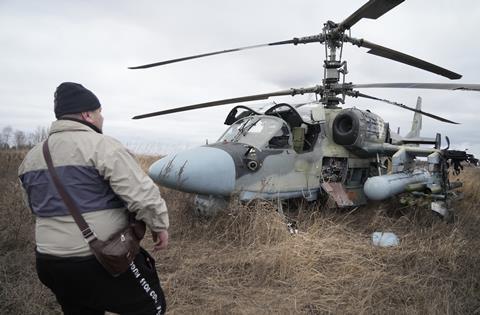The USA has “given the green light” for NATO allies to begin training Ukrainian air force (UAF) pilots to fly the Lockheed Martin F-16 fighter jet.
The US Department of Defense (DoD) on 8 August said President Joe Biden gave formal approval for Washington’s allies in Europe to conduct the training – authorisation required under US law for the American-made F-16.

“Denmark and the Netherlands are taking the lead on training,” Pentagon deputy press secretary Sabrina Singh says on 8 August. “The president has given the green light to allow and support the training to move forward.”
Such approval was widely reported by European governments following the July NATO summit in Vilnius, Lithuania. At the time, representatives from the 11-nation “fighter coalition” orgainsed by Kyiv confirmed they had received approval from Washington for F-16 training.
“F-16s will protect Ukraine’s skies and NATO’s eastern flank,” Ukrainian defence minister Oleksii Reznikov tweeted on 11 July. “The Ukrainian air force is prepared to master them as quickly as possible.”
“The purpose of the training effort is for the Ukrainian air force to have the basic skills and prerequisites to fly, service and maintain F-16 aircraft,” the Danish defence ministry said during the NATO summit.
Reznikov noted that pilots, technicians and support staff from the UAF will all participate in the training programme.
The larger matter of when – and from where – Ukraine will receive the actual fighter jets remains unresolved. Washington has long been hesitant to approve such a transfer, either from its own fleet or those of an ally.
Former NATO Supreme Allied Commander and retired US Air Force General Phillip Breedlove argues that geopolitical concerns over escalating the conflcit are behind Washington’s reluctance.
“I think that the main slowdown in this process is happening inside [the USA], in our capital,” Breedlove says in an 8 August interview with the US-funded broadcaster Voice of America. “There is restraint in taking swift action over fears that Mr. Putin could trigger some important events,” Breedlove adds.
He did not elaborate on what those “important events” might be, although the Biden Administration has in the past warned about the risk of Russia employing tactical nuclear weapons in Ukraine.
While political leaders in the Biden Administration fret over the possibility of an F-16 deal further inciting Russia, generals at the Pentagon argue the expensive, difficult-to-maintain fighters are not the best use of assistance funds going to Ukraine.
“Conditions right now for the employment of the F-16s… they’re probably not ideal,” Lieutenant General Douglas Sims, operations director for the Pentagon’s joint staff, said on 13 July.
“The Russians still possess some air defence capability. They have [air-to-air] capability,” Sims added. “The number of F-16s that would be provided may not be perfect for what’s going on right now.”
Kyiv is in the midst of a large-scale counterattack along multiple portions of the front line between Ukrainian and Russian forces. While neither side in the conflict can claim to have air superiority, such a condition is typically considered necessary for an offensive to succeed, under Western military doctrine.
Ukraine was able to stall Russia’s initial multi-pronged offensive during the early days of the war – without air superiority.

The Pentagon’s top officer, US Army General Mark Milley, in an 18 July press conference suggested that Kyiv can effectively deny Russian aircraft from Ukrainian air space using cheaper ground-based air defence systems, rather than a relatively small number of fighter aircraft.
“The casualties that the Ukrainians are suffering on this offensive are not so much from Russian air power; they’re from minefields, minefields that are covered with direct fire from anti-tank hunter-killer teams, that sort of thing,” said Milley.
“So the problem to solve is minefields, not the air piece right this minute,” he added.
Regardless of that assessment, civilian and military leaders in Kyiv continue to push Washington to approve an F-16 transfer to Ukraine.
Classified Pentagon documents leaked by a member of the Air National Guard in April say both sides in the 18-month war have suffered heavy losses of combat aircraft.
One document estimated Russia has lost 72 fixed-wing and 82 rotary-wing aircraft after the first year of the war.
Ukraine may have fared slightly better, with the US document estimating it has suffered 60 fixed-wing and 32 rotary aircraft destroyed, when the assessment was made in late February.
However, relative to total fleet size, Ukraine’s losses are estimated to be more significant.
Cirium data shows that at the beginning of 2022, before the war started, Ukraine had 112 fighters and 112 combat helicopters. That figure excludes the Ukrainian air force’s Aero Vodochody L-39 Albatross jet trainers, but does include eight RAC MiG-29s and six Su-27s allocated to training duty.
If the casualty estimates are correct, Ukraine has lost 53% of its fighters and 28% of its combat helicopters.
By contrast, the Russian-loss estimates represent a small fraction of its aviation assets.
Cirium data shows Moscow started the war with a massive numerical advantage, counting 1,511 fighters and bombers, plus 1,534 combat helicopters across its combined armed forces. The loss figures from the recent Pentagon leak would represent just more than 4% of Russia’s combat fixed-wing aircraft and only 5% of the country’s combat helicopters.
The Pentagon has not verified any of the information contained in the leaked documents, describing them as still classified.





























